#Nicholas of Greece and Denmark
Text



Prince Nicholas “Greek Nicky” of Greece and Denmark with his 1st-cousins-once-removed Grand Duchesses Olga and Tatiana Nikolaevna, 1899 🤍
#so sweet 🥹#prince nicholas of greece and denmark#Nicholas of Greece and Denmark#olga nikolaevna#tatiana nikolaevna#romanov#otma#romanovs#1899#greek royal family#danish royal family#wolfsgarten
23 notes
·
View notes
Text
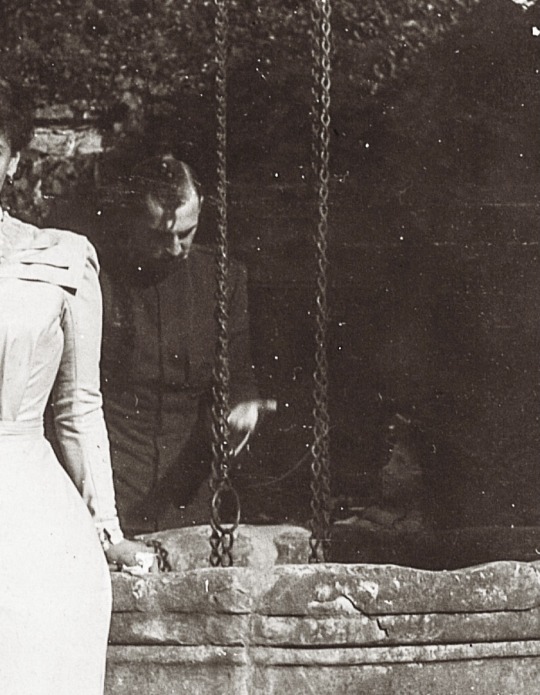
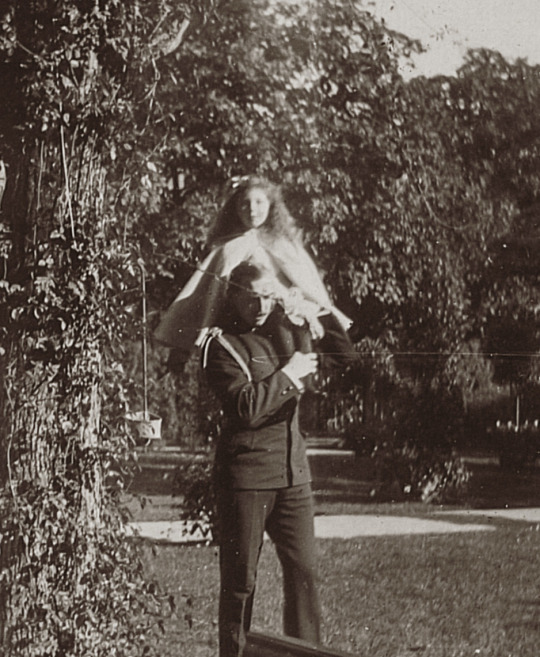
Candid moments between Prince Nicholas of Greece and Denmark aka “Greek Nicky” with his 1st cousin once removed, Princess Elisabeth “Ella” of Hesse, Wolfsgarten, Darmstadt, 1899
#awe cuties 🥰#✨😍🤍#prince nicholas of greece and denmark#prince Nicholas#greek royal family#princess elisabeth of hesse#ella of hesse#elisabeth of hesse#hessian royal family#hesse#wolfsgarten#1899#Nicholas of Greece and Denmark#greek Nicky#danish royal family
22 notes
·
View notes
Text

Family gathering in Denmark, c. 1899.
#romanov#danish royal family#nicholas ii#maria feodorovna#alexandra feodorovna#olga nikolaevna#tatiana nikolaevna#my collection#nicholas of greece#christian x of denmark#alexandrine of mecklenburg schwerin#alexandra of denmark#victoria of wales#irina alexandrovna#andrei alexandrovich
32 notes
·
View notes
Text

Tsar Nicholas II playing around with the princes of Greece and Denmark
1899
#dark academia#light academia#classical#academia aesthetic#escapism#academia#books and libraries#classic literature#books#architecture#old photograph#historical#history#1800s#19th century#tsar nicholas ii#princes#Denmark#Greece#royal core#cottage core#aesthetic#mood#vibe#tumblr
51 notes
·
View notes
Text

Tsarevich Nicholas (later Tsar Nicholas II), Grand Duchesses Xenia and Olga Alexandrovna and Grand Duke Michael Alexandrovich with cousins, including Prince George (later King George V of United Kingdom).
#tsar nicholas ii#king george v#grand duke michael#xenia alexandrovna#olga alexandrovna#greece#england#denmark#tsar#young nicky#grand duke#grand duchess#1894 and early
30 notes
·
View notes
Text

Princess Alice of Battenberg and Tsar Nicholas II of Russia. About 1901.
Nicholas was married to Alexandra, who was the youngest sister of Alice's mother, Victoria. Alexandra and Victoria were born Princesses of Hesse and by Rhine and granddaughters of Queen Victoria via her second daughter, Alice.
In 1903 Alice would marry Prince Andrew of Greece and Denmark, a cousin of Nicholas' and her last born child would become Prince Philip, Duke of Edinburgh, the husband of Queen Elizabeth II. Alice was the grandmother of King Charles III.
Though congenitally deaf, Alice learned to read lips and speak English and German, and also later Greek, the language of her new homeland.
#russian royalty#royalty#romanovs#history#imperial russia#british royalty#german royalty#tsar nicholas ii#russian history#royal women#Princess Alice of Battenberg#Princess Andrew of Greece and Denmark#Princess Alice of Greece and Denmark#Greek Royalty
24 notes
·
View notes
Text
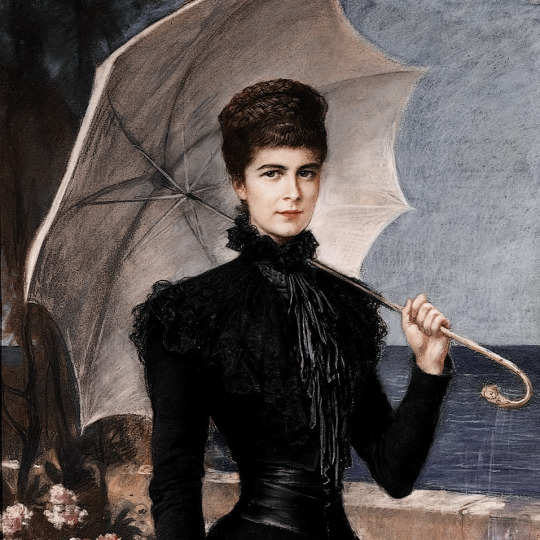

Empress Elisabeth of Austria and her Corfiot palace through the eyes of the Greek royals.
Greece was destined to offer the Empress Elisabeth the hospitality of its soil. She chose Greece as the country where she would hide herself and her sorrow. At Corfu she bought a site of ground from an old Corfiote Statesman called Braïla, and on it she built the Palace which she called "Achilleion", after her hero Achilles, whose statue was in the middle of the top garden terrace, and represented him at the hour of his death, drawing the arrow out of his heel. When in Corfu, it was understood, she was to be strictly incognito, and her wishes were always respected.
One day, suddenly, when we least expected it, she arrived at Athens, having travelled by the ordinary steamer, and called at the Palace accompanied by a lady -in-waiting. She asked the porter whether she could see the King and Queen. On the porter's inquiring who she was, she replied she was "the Empress of Austria." Whereupon we were brought down to verify that statement . It seemed impossible╴but it was the Empress of Austria! Needless to say she obtained her interview, and after half an hour's conversation she took her departure, insisting that her visit should not be returned by my parents.
As she was anxious to study Greek culture, she decided to learn modern Greek, and applied herself to the task with great energy and perseverance. She engaged a tutor for Greek conversation. Her first was Dr. Christomanos, an author and poet, who wrote a charming life of the Empress, which was translated into several languages. Her last was Count A. Mercati, who afterwards became Master of King Constantine's household.
Accompanied by her tutor, the Empress used to go off on a five or six hours' walk, all over the island; and even for the picturesque ceremony of combing and brushing her hair the tutor had to be present, talking Greek to her all the time. She learnt to speak Greek quite faultlessly. In the arrangement of her house the Empress took great pride, setting up the statues of all her new "Gods"; Sophocles, Euripides, Plato and Aristotle. She also had a statue of Heine, the poet, erected in a shrine.
When the Kaiser bought the Achilleion, he at once banished Heine, and raised Achilles from his recumbent position into a standing War Lord, with gilded helmet and shield, so that the first sight of Achilleion should be his glittering helmet.
It is a pity that the Empress tried to improve the natural beauty of the spot. Her lack of taste, I may even ungraciously say her eccentricities, were almost an eyesore. There was a grotto of artificial rock and mirrors, destined as a home for monkeys, who luckily never came to inhabit it. Though the island abounded in oranges, she sent to Italy for her fruit.
The view from the terrace over all the plain of Corfu, with its olive groves groups cypresses on one side and the sea and the mountains of Albania on the other one of the most exquisite I have ever seen.
The memoirs of His Royal Highness, Prince Nicholas of Greece and Denmark, My fifty years, 1926.
I was a child when the Empress came to Athens and saw her only once or twice, but I remember her more vividly than many people I knew far better. I imagine it was the same with everyone who came in contact with her. Her brilliant, beautiful and restless personality left an indelible impression.
She was so enchanted with Greece that she decided to build a villa in Corfu. The site she chose could not have been more beautiful, about twelve miles outside the town, set on a high hill overlooking the sea on one side and a chain of mountains on the other. But she was too impatient even to look at the plans and gave the architect carte blanche. So instead of the simple cottage she had intended he erected an orate and hideous palace lavishly adorned with frescoes, statues and bronzes of every description. This atrocity cost the Austrian Govemment twelve million crowns, I believe.
The Empress's life was dominated by the fear of losing her beauty. As she grew older it became an obsession. Hours were spent every moring brushing the glotious brown hair that she wore gathered into two great plaits coiled around her head.
This hair-brushing was a matter of solemn ritual. Any hairs that fell out during the process were carefully collected and presented to the Empress on a silver salver. If their number proved to be too many the entire day was blackened to her.
Once a captain of a Russian gunboat reported that he had seen a yacht coming into the Piraus harbour with a woman seated on the deck whose mass of hair reached down to the ground while two attendants stood behind her brushing it. " That could only be the Empress of Austria." said my father, when he heard the story.
Later in the day a carriage drove up to the Palace and a mysterious visitor was announced, a lady who refused to give her name. It was, as we expected, the Empress Elizabeth.
She insisted on preserving a strict incognito while she was in Greece, although it seemed rather unnecessary, since everyone knew who she was.
She detested nothing so much as being photographed, or even looked at for that matter, and always carried a large fan with her on her walks, so that she could unfurl it and hide her face from the passers-by.
The Empress was a fine woman in many respects, far finer, I think, than most of her biogtaphers have represented her. Intelligent, intuitive, sensitive, she had all the qualities to make a great empress. But she was tragically lacking in a sense of proportion. Even in the small issues of everyday life she had no idea of modera-tion. She could not take anything up without making it a mania.
While she was in Corfu she set herself to learn Greek, although she had gone there to rest. Now Greek is a complicated language and its study is hardly to be recommended as a restful pursuit. The Empress certainly did not regard it as such either for herself or any one else, for she wore out her two teachers, Count Mercati and Mr. Christomanos. Every day she walked ten or twelve miles with one or the other, talking Greek all the way and, even during the hair-brushing ceremony, one of them was always present reading to her.
Her figure became another obsession with her.
Although she was exaggeratedly slender when she came to Greece (she weighed, I believe, only seven stones) no Hollywood film star could have followed out a more Spartan regime. Her constant dieting made her irritable and depressed. Even when she lunched with my mother and father she would often eat nothing but a salad and some fruit, and she would start off immediately afterwards on one of her exhausting walks, skimming over the ground like a restless, beautiful wraith.
The memoirs of His Royal Highness, Prince Christopher of Greece and Denmark, 1938.
#long af post i’m sorry#empress elisabeth of austria#empress sisi#greek royal family#prince nicholas of greece and denmark#prince christopher of greece and denmark
121 notes
·
View notes
Text

Grand Duchess Elena Vladimirovna of Russia, later Princess Nicholas of Greece and Denmark
Greek vintage postcard
#ephemera#photography#vintage#briefkaart#grand duchess#elena#nicholas#carte postale#postcard#photo#later#greece#vladimirovna#sepia#ansichtskarte#duchess#greek#grand#postkarte#postkaart#russia#elena vladimirovna#princess#postal#denmark#tarjeta#historic
9 notes
·
View notes
Text
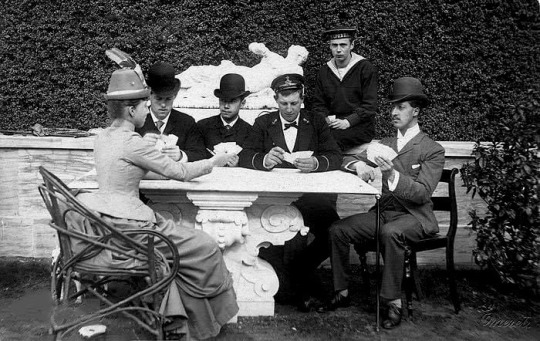
Cousins playing cards, late 1880's
Princess Alexandra of Greece and Denmark, Crown Prince Constantine of Greece and Denmark, Tsesarevich Nicholas, Prince George of Greece and Denmark, Grand Duke George Alexandrovich, Prince Albert Victor of Wales.
#alexandra georgievna#king constantine i#tsesarevich nicholas#George of Greece and Denmark#george alexandrovich#prince albert victor#1880s#danish royal family#nicholas ii#grand duke george#albert victor#alexandra of greece
47 notes
·
View notes
Text
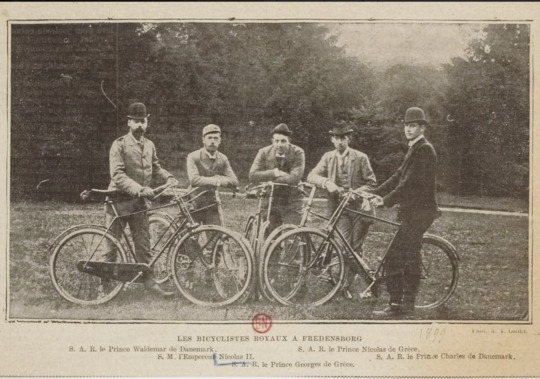
THE BICYCLE WAS ALL THE RAGE, SO THE ROYALS HAD TO GET INTO CYCLING
On the photo above, from left to right: Prince Valdemar of Denmark, Emperor Nicholas II, “Greek Georgie” (Prince George of Greece), “Greek Nicky” (Prince Nicholas of Greece) and Prince Christopher of Denmark. These guys really dressed up to go riding…neck tie, hat…
On the photo below, from left to right, Grand Duke Mikhail Alexandrovich…the jock of the group as usual, notice the handle of his bike; Cousin Victoria of Wales with an incredibly small waist, Queen Maud and her handsome and intelligent husband Hakoon VII.

#russian history#imperial russia#nicholas ii#vintage photography#prince nicholas of greece and denmark#prince george of greece#Grand Duke Mikhail Alexandrovich#Princess Victoria of Wales#Queen Maud of Norway#King Haakon VII of Norway#prince Charles of denmark
17 notes
·
View notes
Text
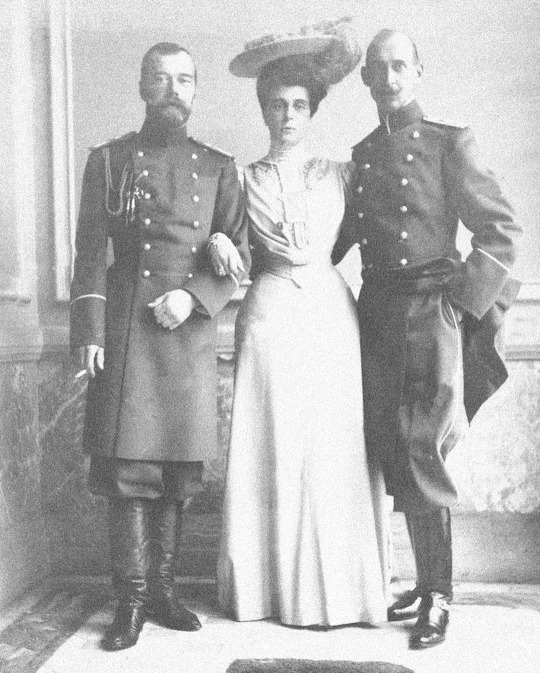
(L–>R)
Tsar Nicholas II of Russia with his 1st cousin, Grand Duchess Elena Vladimirovna of Russia, and her husband, Prince Nicholas of Greece and Denmark.
9 notes
·
View notes
Text
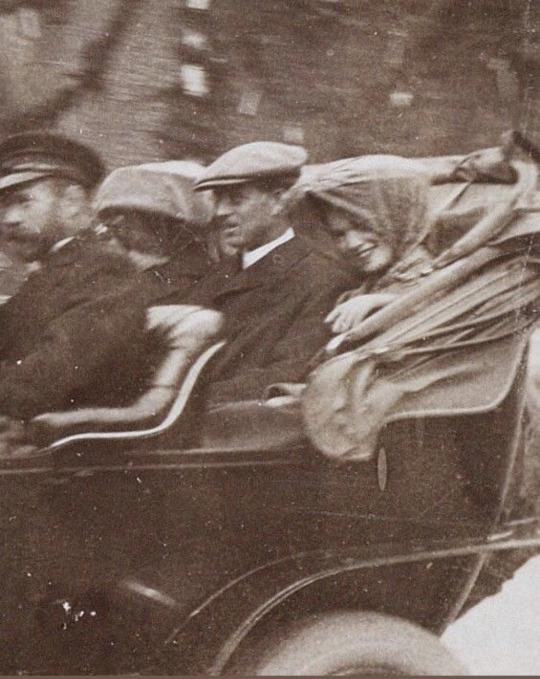
Crop of a smiling Grand Duchess Olga Nikolaevna with father Tsar Nicholas II, 1st-cousin-in-law and 1st-cousin-once-removed Prince Andrew of Greece and Denmark, and probably Grand Duchess Tatiana Nikolaevna, 1910
#olga nikolaevna#tsar nicholas ii#Prince Andrew of Greece and Denmark#1910#Romanovs#Romanov#OTMA#greek royal family#russian imperial family#russian history#prince Andrew#prince Andrew of Greece#Nicholas ii#grand duchess olga nikolaevna
93 notes
·
View notes
Note
Hello! Was the marriage of George Mikhailovich and his wife really disastrous? Thank you.
Hello there! Thank you for your question.
Grand Duke Georgiy Mikhailovich married Princess Maria of Greece and Denkark in 1900. Upon the marriage, she became 'Maria Georgievna'. Georgiy seemed very much in love with Maria at first, he courted her for five years before she decided to marry him, having turned him down initially. They seemed to be, on paper, a good match - they were notably both very artistic, and together they designed their own English-style house in the Crimea, called Harax.

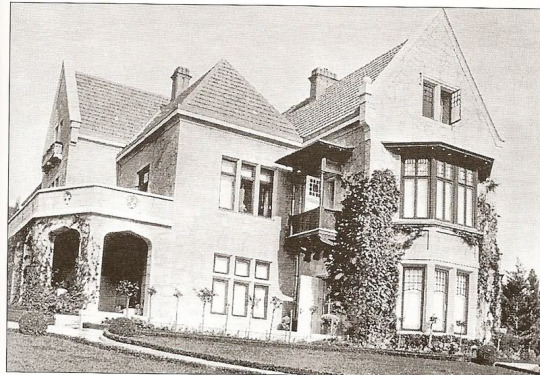
They were close with the Romanovs, especially Xenia Alexandrovna, who was Maria's best friend, cousin, AND sister-in-law! Georgiy and Maria's daughters occasionally played with Maria and Anastasia Nikolaevna, and were friendly with Nicholas and Alexandra.


Unfortunately, Maria never seemed to be able to settle in Russia and longed to return to Greece, which I suspect put strain on the marriage. The final blow (in my opinion) came in 1913, when Maria's father King George I of Greece was assassinated. It was such a shock and she was devastated. This was even more distressing as it was the Romanov Tercentenary year, and Georgiy and Maria were expected to attend celebrations, despite being deep in mourning.
Maria seemed to have been deeply unhappy, and took her children to London in 1914 as a way to take a break from the marriage, with Georgiy meant to follow them to London later on. Of course, Maria couldn't have predicted war would break out, but it meant that there was an excuse to stay in London and away from Russia where she was unhappy, as her and her daughters couldn't travel back to Russia due to the danger it posed. It is believed that her daughters, Nina and Xenia, who had tumultuous relationship with their mother, always resented her for taking them away from their father in 1914 - he would be shot in 1919, and they would never see him again after the move to London.
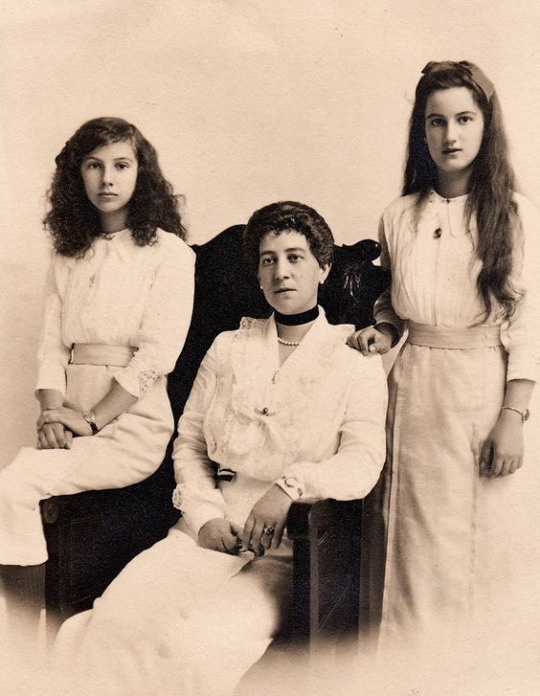
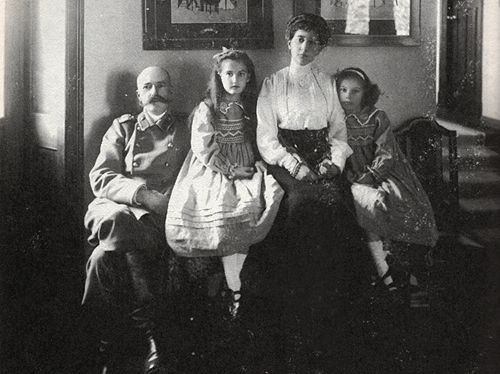
Despite this, there was clearly some affection between Georgiy and Maria. From London, Maria tried desperately to help Georgiy, contacting Russian relatives, the Danish embassy, and offering £50,000 (almost £3,000,000 today) of her own money in return for him being freed.
So, their marriage wasn't absolutely disastrous - there seems to have been some closeness and they clearly shared common interests. Their collaboration on Harax especially indicates that they had a good partnership. Despite this, Maria never seemed able to fall in love with Georgiy, or Russia. It wasn't a success by any means, but they did not hate each other.
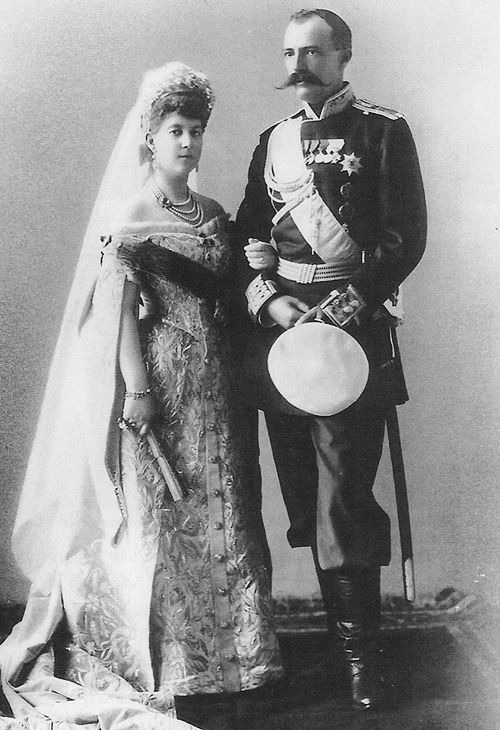
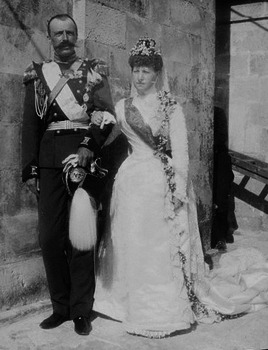
#q#anon#ask#answered#Maria Georgievna#Maria of Greece and Denmark#George Mikhailovich#Georgiy Mikhailovich#Nicholas II#Xenia Alexandrovna#Harax#Harax palace#1919#Xenia Georgievna#Nina Georgievna#Mikhailovichi
13 notes
·
View notes
Text
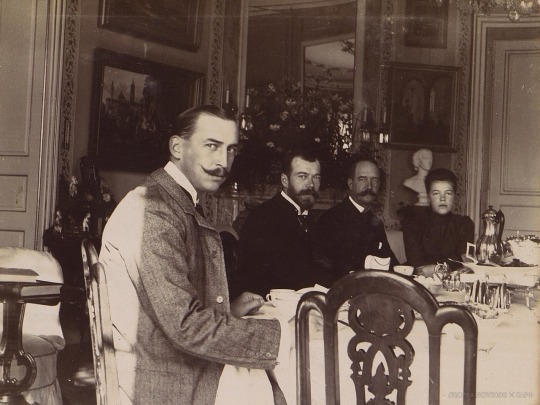
Nicholas II, his sister Olga and their European relatives: King George I of Greece and Prince Nicholas of Greece (front) at a family reunion in Denmark, 1899
29 notes
·
View notes
Text
George and Marina: Duke and Duchess of Kent by Christopher Warwick #HouseofWindsor #Audiobook #BookReview
The #AudiblePlus catalog had a few books on the #royalfamily that I had to check out. One was about the #DukeandDuchessofKent, #QueenElizabethII aunt and uncle. #PrinceGeorge and #PrincessMarina both came from royal houses. #Audiobook #BookReview
For eight brief years, before he was tragically killed in a mysterious air crash during the Second World War, Prince George, Duke of Kent, son of King George V and Queen Mary, and his beautiful wife, Princess Marina of Greece and Denmark, were the British monarchy’s, indeed, high society’s, most glamorous royal couple; and as golden royal icons they are still remembered.As a young man,…

View On WordPress
#Abdication#Abdication Crisis#Albert Bridge Books#Duchess of Kent#Duke and Duchess of Kent#Duke of Kent#George and Marina#Grand Duchess Yelena Vladimirovna#House of Windsor#King Edward VIII#King George V#King George VI#Prince Edward#Prince George#Prince Nicholas of Greece#Prince of Wales#Princess Marina#Princess Marina of Greece and Denmark#Queen Elizabeth#Queen Mary#Tantor Audio
2 notes
·
View notes
Text

Gathering of Russian, Danish, and Greek Royal families in Denmark 1860s-70s
(Im sorry if I identify some people wrong but I will try my best to get them right!)
Back row from left to right: Princess Louise of Wales, Tsarina Maria Feodrovna, King George I of Greece, Queen Olga Konstantinovna of Greece, Crown Princess Louisa of Denmark, Prince Carl of Denmark(?), Prince Christian of Denmark(?), Alexandra Princess of Wales
Middle row from left to right: Grand Duke Michael Alexandrovich, Tsarevich Nicholas Alexandrovich, Princess Maud of Wales, Grand Duchess Xenia Alexandrovna, Princess Dagmar of Denmark(?)
Sitting from left to right: Grand Duke George Alexandrovich, Princess Alexandra of Greece and Denmark, (I dont know who the little boy is next to Princess Alexandra is), Princess Victoria of Wales, (i do not know who the little girl is next to Princess Victoria)
If anyone knows who the people i can identify or who i got wrong please let me know!!!
#european monarchies#denmark#queen olga of greece#queen alexandra#greece#imperial russia#1800s#tsar nicholas ii
3 notes
·
View notes